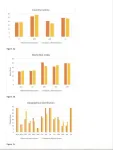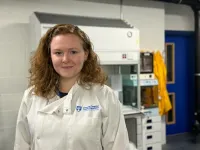Presented today at UEG Week 2024, the study focuses on an enzyme called Sterol O-acyltransferase 2 (SOAT2), which plays a critical role in fat absorpsion in the small intestine.3,4 By inhibiting this enzyme in the small intestine, the study offers a promising therapeutic approach to reduce fat absorption and potentially prevent obesity.
Despite extensive research into fat metabolism, effective inhibitors of intestinal fatty acid uptake have until now remained elusive. “For years, researchers have studied fat metabolism, but finding an effective way to block fat absorption has been difficult,” explained lead researcher Dr Wentao Shao. “While most strategies focus on reducing dietary fat intake, our approach targets the body’s fat absorption process directly."
The research team developed an innovative delivery system using nanoparticles – a tiny capsule made from a polymer core, coated in a protective shell. The system was designed to efficiently carry small interfering RNAs (siRNAs) to the small intestine, where they can reduce SOAT2 expression, inhibiting fat absorption. In mouse models, the animals treated with the nanoparticle therapy absorbed less fat and avoided obesity, even on a high-fat diet.
“This oral treatment offers several advantages”, said Dr Shao. “It’s non-invasive, has low toxicity, and it has high potential for better patient compliance compared to current obesity treatments, which are often invasive or difficult to maintain. This makes it a promising alternative.”
The study also uncovered the underlying mechanism by which SOAT2 regulates fat absorption. Inhibition of SOAT2 in the small intestine triggers degradation of CD36, a protein reponsible for transporting fat. This process involves both cellular stress and the recruitment of E3 ligase RNF5, an enzyme that enhances CD36 degradation.
Previous studies have shown that blocking hepatic SOAT2 leads to fat accumulation in the liver, 5,6 whereas this intestine-specific approach circumvents that risk, offering a safer and more focused treatment for obesity.
Professor Zhaoyan Jiang, study supervisor, explained, “One of the most exciting aspects of this therapy is its ability to target fat absorption in the intestines without affecting the liver. This is important because previous studies showed that blocking SOAT2 in the liver can lead to fat buildup there – a risk our treatment avoids by focusing only on intestinal SOAT2.”
Looking ahead, the research team plans to test the nanoparticle system in larger animal models to confirm its effectiveness and safety for potential use in humans.
“We believe that this nanoparticle system represents a breakthrough in obesity management, offering a new solution that tackles both fat metabolism and diet-related weight gain, potentially ushering in a new era of more effective treatments”, Professor Jiang concluded.
END
Notes to Editors
For further information or to arrange an expert interview, please contact media@ueg.eu.
We kindly ask that a reference to UEG Week 2024 is included when communicating any information within this press release.
About the Author:
Wentao Shao is a PhD candidate specialising in basic medical research at the Center of Gallstone Disease, Shanghai East Hospital, Tongji University, China.
The project was supervised by Professor Zhaoyan Jiang and Professor Ai-Hua Gu. Professor Zhaoyan Jiang is a researcher at the Center of Gallstone Disease, Shanghai East Hospital, while Professor Ai-Hua Gu is a Professor at the School of Public Health, Nanjing Medical University, China.
About UEG:
Founded in 1992, United European Gastroenterology (UEG) is the leading non-profit organisation for excellence in digestive health in Europe and beyond with its headquarters in Vienna. We improve the prevention and care of digestive diseases in Europe through providing top tier education, supporting research and advancing clinical standards. As Europe’s home for multidisciplinary gastroenterology, we unite over 50,000 engaged professionals from national and specialist societies, individual digestive health experts and related scientists from all fields. With our innovative online platform, the ‘myUEG Community’, we enable digestive health professionals from across the globe to connect and benefit from a plethora of outstanding free resources and educational activities. Our offers include UEG Week, our annual congress, online and face-to-face educational experiences, research support, a scientific journal and a range of opportunities in the form of fellowships and grants. We provide numerous guidelines, standards and quality improvement initiatives and campaign at the European level to ensure continued resources for research into digestive health while working closely with patient organisations.
Find out more about UEG’s work by visiting: www.ueg.eu
References:
Shao W, et al. Sirna/CS-PLGA nanoparticles system targeting knockout of intestinal SOA SOAT2 reduced intestinal lipid uptake and alleviate obesity. Presented at UEG Week 2024; 14 October 2024; Vienna, Austria.
Liang, J., Shao, W., Ni, P., Liu, Q., Kong, W., Shen, W., Wang, Q., Huang, A., Zhang, G., Yang, Y., Xin, H., Jiang, Z., & Gu, A. (2024). siRNA/CS-PLGA nanoparticle system targeting knockdown intestinal SOAT2 reduced intestinal lipid uptake and alleviated obesity. Advanced Science. https://doi.org/10.1002/advs.202403442
Azuma, Y., Kawasaki, T., Ikemoto, K., Obata, K., Ohno, N., Sajiki, N., Yamada, T., Yamasaki, M., & Nobuhara, Y. (1998). A study on the effects of dietary fatty acids. Japanese Journal of Pharmacology, 78, 355-364.
Marzetta, C. A., Savoy, Y. E., Freeman, A. M., Long, C. A., Pettini, J. L., Hagar, R. E., Inskeep, P. B., Davis, K., Stucchi, A. F., & Nicolosi, R. J. (1994). Sterol O-acyltransferase activity in the esterification of cholesterol. Journal of Lipid Research, 35, 1829-1838.
Alger, H. M., Brown, J. M., Sawyer, J. K., Kelley, K. L., Shah, R., Wilson, M. D., Willingham, M. C., & Rudel, L. L. (2010). The role of SOAT2 in cholesterol esterification in the liver. Journal of Biological Chemistry, 285(19), 14267-14277.
Brown, J. M., Bell, T. A. III, Alger, H. M., Sawyer, J. K., Smith, T. L., Kelley, K., Shah, R., Wilson, M. D., Davis, M. A., Lee, R. G., Graham, M. J., Crooke, R. M., & Rudel, L. L. (2008). SOAT2 inhibition in hepatic cholesterol metabolism. Journal of Biological Chemistry, 283(15), 10522-10532. END



